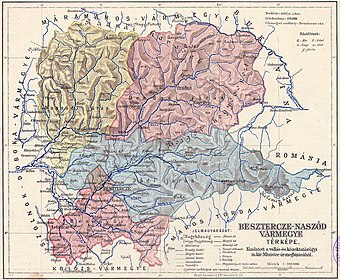Beszterce-Naszód County
| Beszterce-Naszód County Comitatus Bistriciensis-Naszodiensis (Latin) Beszterce-Naszód vármegye (Hungarian) Komitat Bistritz-Naszod (German) Comitatul Bistriţa-Năsăud (Romanian) | |||||
County of the Kingdom of Hungary | |||||
| |||||
 Coat of arms Coat of arms | |||||
 | |||||
Capital | Beszterce 47°8′N 24°30′E / 47.133°N 24.500°E / 47.133; 24.500Coordinates: 47°8′N 24°30′E / 47.133°N 24.500°E / 47.133; 24.500 | ||||
History | |||||
| • | Established | 1876 | |||
| • | Treaty of Trianon | June 4, 1920 | |||
Area | |||||
| • | 1910 | 4,333 km2(1,673 sq mi) | |||
Population | |||||
| • | 1910 | 127,800 | |||
Density | 29.5 /km2 (76.4 /sq mi) | ||||
Today part of | Romania | ||||
Bistrița is the current name of the capital. | |||||
Beszterce-Naszód was an administrative county (comitatus) of the Kingdom of Hungary. Its territory is now in northern Romania (north-eastern Transylvania). The capital of the county was Beszterce (now Bistrița).
Contents
1 Geography
2 History
3 Demographics
4 Subdivisions
5 References
Geography
Beszterce-Naszód county shared borders with the Kingdom of Romania, the Austrian Bukovina, and the Hungarian counties Máramaros, Szolnok-Doboka, Kolozs, Maros-Torda, and Csík. Its area was 4167 km² around 1910.
History
Beszterce-Naszód county was formed in 1876, when the Transylvanian Saxon district of Beszterce/Bistritz was united with the district of Naszód (since 1861, 1762–1851 military frontier district) and part of Doboka county. In 1920 the Treaty of Trianon assigned the territory of Beszterce-Naszód county to Romania. In 1940 by the Second Vienna Award it was returned to Hungary and was occupied until 1944 during World War II. The territory of the county is now in the (larger) Romanian county Bistrița-Năsăud.
Demographics
In 1900, the county had a population of 119,014 people and was composed of the following linguistic communities:[1]
Total:
Romanian: 82,256 (69,1%)
German: 26,036 (21,9%)
Hungarian: 8,475 (7,1%)
Ruthenian: 165 (0,1%)
Slovak: 128 (0,1%)
Serbian: 4 (0,0%)
Croatian: 9 (0,0%)- Other or unknown: 1,941 (1,6%)
According to the census of 1900, the county was composed of the following religious communities:[2]
Total:
Greek Catholic: 66,078 (55,5%)
Lutheran: 22,874 (19,2%)
Eastern Orthodox: 15,290 (12,9%)
Jewish: 6,385 (5,4%)
Roman Catholic: 4,927 (4,1%)
Calvinist: 3,349 (2,8%)
Unitarian: 101 (0,0%)- Other or unknown: 10 (0,0%)

Ethnic map of the county with data of the 1910 census (see the key in the description)
In 1910, county had a population of 127,843 people and was composed of the following linguistic communities:[3]
Total:
Romanian: 87,564 (68,5%)
German: 25,609 (20,0%)
Hungarian: 10,737 (8,4%)
Ruthenian: 213 (0,2%)
Slovak: 37 (0,0%)
Croatian: 11 (0,0%)
Serbian: 6 (0,0%)- Other or unknown: 3,666 (2,9%)
According to the census of 1910, the county was composed of the following religious communities:[4]
Total:
Greek Catholic: 72,494 (56,7%)
Lutheran: 22,415 (17,5%)
Eastern Orthodox: 16,615 (13,0%)
Jewish: 7,254 (5,7%)
Roman Catholic: 5,083 (4,0%)
Calvinist: 3,781 (3,0%)
Unitarianist: 200 (0,1%)- Other or unknown: 1 (0,0%)
Subdivisions

In the early 20th century, the subdivisions of the county Beszterce-Naszód were:
| Districts (járás) | |
|---|---|
| District | Capital |
| Besenyő | Beszterce, (Romanian: Bistrița) |
| Jád | Beszterce, (Romanian: Bistrița) |
| Naszód | Naszód, (Romanian: Năsăud) |
| Óradna | Óradna, (Romanian: Rodna) |
| Urban districts (rendezett tanácsú város) | |
| Beszterce, (Romanian: Bistrița) | |
References
^ "KlimoTheca :: Könyvtár". Kt.lib.pte.hu. Retrieved 2012-12-06..mw-parser-output cite.citation{font-style:inherit}.mw-parser-output .citation q{quotes:"""""""'""'"}.mw-parser-output .citation .cs1-lock-free a{background:url("//upload.wikimedia.org/wikipedia/commons/thumb/6/65/Lock-green.svg/9px-Lock-green.svg.png")no-repeat;background-position:right .1em center}.mw-parser-output .citation .cs1-lock-limited a,.mw-parser-output .citation .cs1-lock-registration a{background:url("//upload.wikimedia.org/wikipedia/commons/thumb/d/d6/Lock-gray-alt-2.svg/9px-Lock-gray-alt-2.svg.png")no-repeat;background-position:right .1em center}.mw-parser-output .citation .cs1-lock-subscription a{background:url("//upload.wikimedia.org/wikipedia/commons/thumb/a/aa/Lock-red-alt-2.svg/9px-Lock-red-alt-2.svg.png")no-repeat;background-position:right .1em center}.mw-parser-output .cs1-subscription,.mw-parser-output .cs1-registration{color:#555}.mw-parser-output .cs1-subscription span,.mw-parser-output .cs1-registration span{border-bottom:1px dotted;cursor:help}.mw-parser-output .cs1-ws-icon a{background:url("//upload.wikimedia.org/wikipedia/commons/thumb/4/4c/Wikisource-logo.svg/12px-Wikisource-logo.svg.png")no-repeat;background-position:right .1em center}.mw-parser-output code.cs1-code{color:inherit;background:inherit;border:inherit;padding:inherit}.mw-parser-output .cs1-hidden-error{display:none;font-size:100%}.mw-parser-output .cs1-visible-error{font-size:100%}.mw-parser-output .cs1-maint{display:none;color:#33aa33;margin-left:0.3em}.mw-parser-output .cs1-subscription,.mw-parser-output .cs1-registration,.mw-parser-output .cs1-format{font-size:95%}.mw-parser-output .cs1-kern-left,.mw-parser-output .cs1-kern-wl-left{padding-left:0.2em}.mw-parser-output .cs1-kern-right,.mw-parser-output .cs1-kern-wl-right{padding-right:0.2em}
^ "KlimoTheca :: Könyvtár". Kt.lib.pte.hu. Retrieved 2012-12-06.
^ "KlimoTheca :: Könyvtár". Kt.lib.pte.hu. Retrieved 2012-06-19.
^ "KlimoTheca :: Könyvtár". Kt.lib.pte.hu. Retrieved 2012-06-19.
